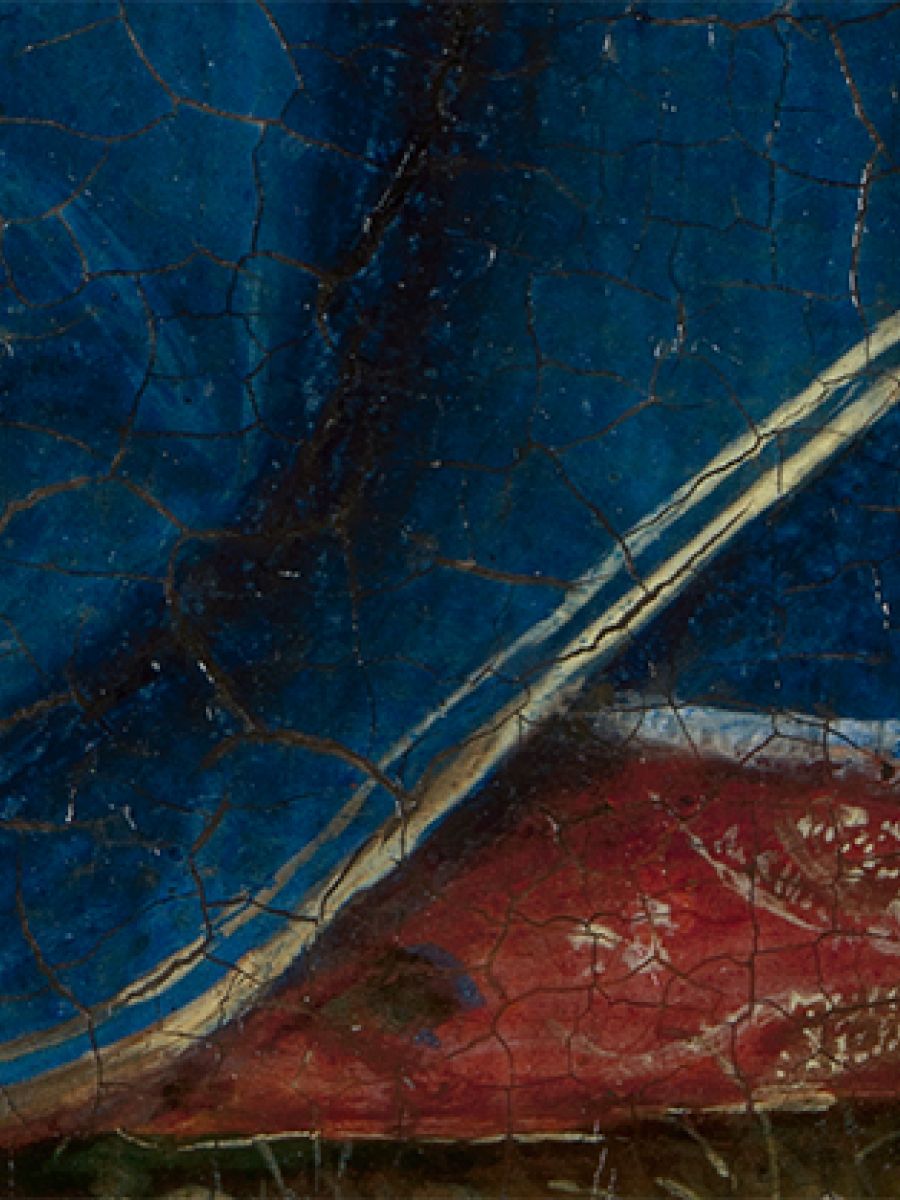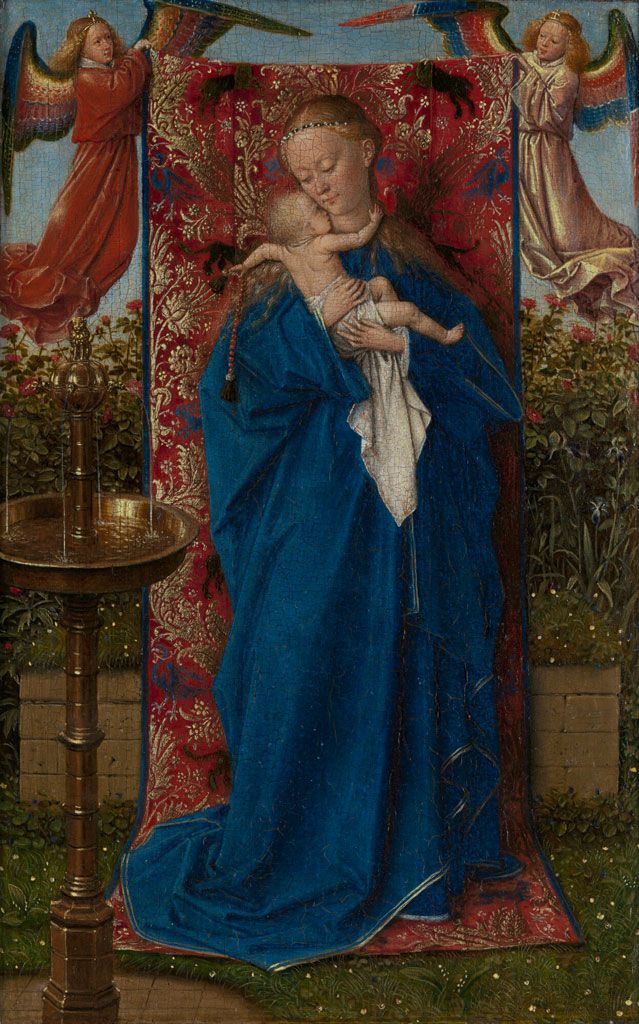Small but perfectly formed

Nothing was ever good enough for Jan van Eyck. We find the same attention to detail and finish, whether he was painting immense altarpieces or the smallest panels. It was towards the end of his life that the Flemish Primitive painted his tiny Madonna at the Fountain to place on the private altar of an unidentified patron. Van Eyck’s urge to innovate is apparent in this little work too. What were his secrets? How did he come up with his magic formula, so very different from his contemporaries?
1. Oil makes all the difference
Jan van Eyck was the first artist to get the most out of oil paint. Painters generally worked at the time with tempera, an opaque blend of egg and pigment. But Van Eyck wanted greater variety and colours that were less flat.
The oil paint he used was made to his own recipe. This almost certainly included additives to make the paint dry faster, with the result that it was easier to use in practice. Precisely what those ingredients were and the proportions in which they were mixed remain a mystery. What we do know is that he added resins, so that the paint dried smoothly, leaving no trace of his brush strokes.
You can’t paint directly onto a wooden panel in oils: a ground layer or primer has to be applied first. The colour of this preparatory coating changed over the centuries. In Van Eyck’s case it took the form of a white layer made of chalk and animal-based glue, which also influenced the finished result.

If you look closely you can see windows reflected in the fountain.

Zoomed in
For the most part, Van Eyck built up his paintings by applying very thin layers of transparent paint on top of one another, like layers of coloured varnish or glaze. These do not always have precisely the same shade or colour: the tone we ultimately see is blended in our own brains. The white ground layer reflects through all these transparent layers, giving the colours their lasting vivacity.
Van Eyck laid thick, opaque strokes of white or light yellow on top of darker, transparent layers to suggest places where the light is reflected back completely, such as the windows in the fountain.
2. Most expensive pigment
Jan van Eyck’s ultramarine took a long time to reach him. The name of the pigment comes from the Italian oltromarino meaning ‘over the sea’, but it actually came from a lot further away than that: a location 7,000 km or so from Bruges, which is still considered ‘inhospitable’ and ‘dangerous’ to this day. The mines were located between the jagged mountain peaks of Afghanistan in places where no European had set foot. And yet Afghan merchants had been exporting lapis lazuli from there since the age of the Egyptians. From the thirteenth century onwards, it was the Venetians who imported the blue, semiprecious stone, which yields a divine, midnight blue reserved for depictions of the Virgin Mary’s dress.
The first step for the Venetian paintmakers was to extract the pigment, which they achieved by crushing the stones and then mixing the powder with a dough consisting of resin, wax, gum and linseed oil. The result was kneaded in a pot of water for three days, during which the pigment settled out onto the bottom. Having been allowed to dry, the pigment was shipped out all across Europe, including Bruges.

Zoomed in

The ultramarine instantly lent Mary a regal air.
It is not surprising, then, that ultramarine was the most expensive pigment in Van Eyck’s time. Even today, a kilogram produced in the traditional way costs about 8,000 euros and part of the Afghan economy still revolves around the export of lapis lazuli.
Jan van Eyck began by painting Mary’s robe and all its folds in azurite – a cheaper mineral sourced from Germany that gives a lovely, bright blue. To do the Virgin full justice, however, he needed another blue besides, an enigmatic blue with a purple tone. The most perfect pigment: the ultramarine that, as if by magic, instantly lent Mary a regal air.
3. The power of suggestion
Works by Jan van Eyck are an accumulation of razor-sharp details. His little Madonna at the Fountain includes an identifiable rose just two millimetres across, and a bead measuring half a millimetre that seems to reflect the light. And yet this precision is not real: what Van Eyck excelled at most of all was the power of suggestion. It’s all about the details.

A rose at two millimeters

Lilies in detail
Viewed full scale, you notice lily of the valley in the grass, near to a brocade cloth of honour and Mary’s gold-trimmed robe. If we zoom in closely to a scale of one millimetre, however, it’s a different story. We find that he hasn’t even drawn the stems of the lilies, while the grass is an ingenious combination of a brown ground with green spots and transparent white highlights. And yet the picture works.

Zoomed in - Van Eyck imitates gold using paint
It was in his handling of gold that Van Eyck revealed his true mastery. No more sticking actual gold leaf on the painting for him, especially as a background. Instead, he used paint to imitate gold. We can already see this clearly at the bottom of Mary’s robe. By pressing his brush harder and more softly, he obtained thinner and thicker strokes, and light as well as somewhat darker nuances. Fast and precise.
This is even more obvious when you look at the way Van Eyck imitated the gold thread in the brocade cloth of honour. Viewed full scale, you can see that he knew exactly how gold reflects light. And he also took account of the folds in the cloth and of Mary’s shadow.

Van Eyck makes the gold thread shine with tonal variations, thin lines and small dots

Zoomed in
At a two millimetre scale, meanwhile, you discover how the artist exploited the red of the cloth. Using variations in tone, small, thin lines and tiny dots he not only caused the gold thread to gleam, he also imbued it with volume and laid it on top of the red fabric so that it looks absolutely real.
4. Theatre of symbolism
Jan van Eyck did not apply a strictly mathematical perspective to lend depth to his scenes: he resorted to other tricks instead, making us the audience for a theatrical performance. Van Eyck constructed his ‘stage sets’ by placing the different elements one behind another, which is what we find in this little work too.

Our eyes move from the fountain to Mary cuddling her son, and from Mary to the angels all the way in the background. Together, this sequence represents the transition between earth and air. It’s simple yet incredibly effective.
This tiny theatre is full of symbolism too: everything has a meaning. The fountain is the mythical one of Eternal Life, alluding to Mary as a source of life and of flowers, but also to Jesus for similar reasons. The decorative dragons and lion derive from a Bible text. The reflection of the sunlit windows, meanwhile, refers to Mary’s purity. The little flowers symbolize her too, and probably many other details as well that we can no longer explain.



